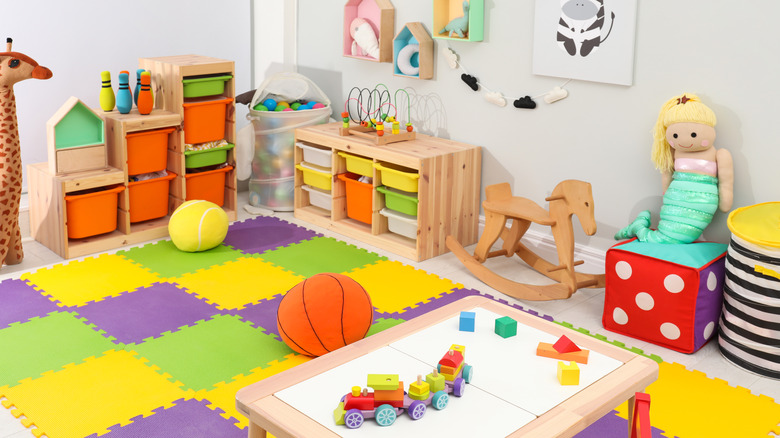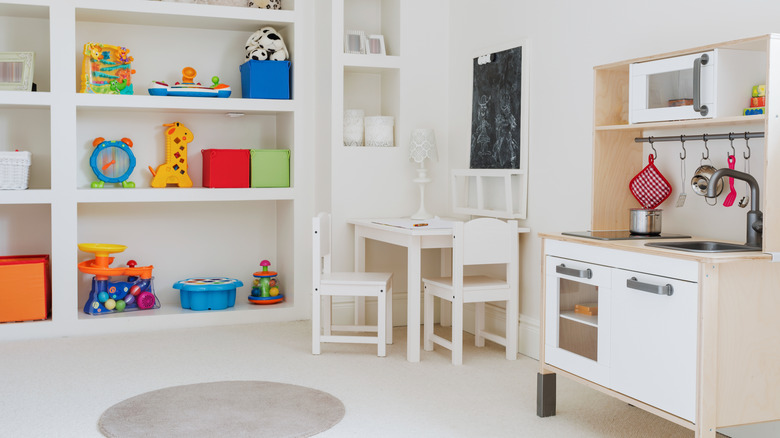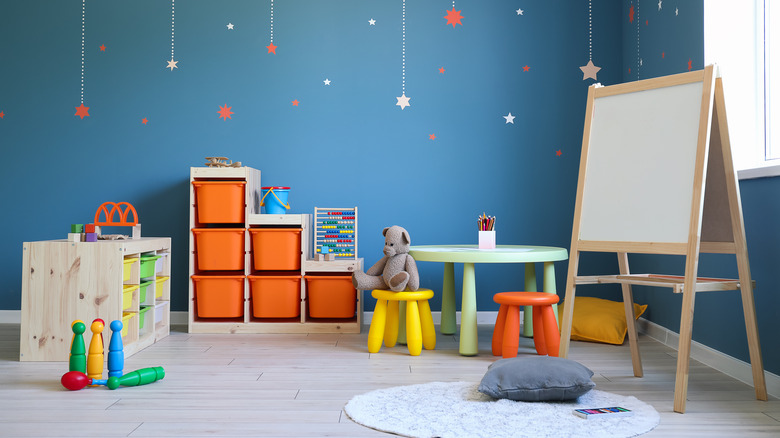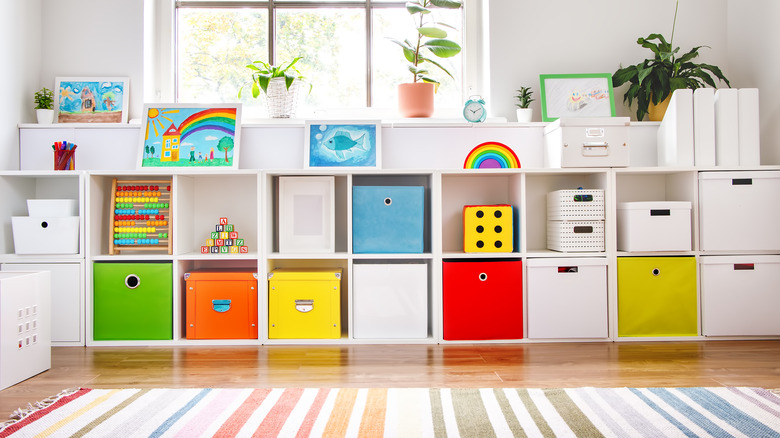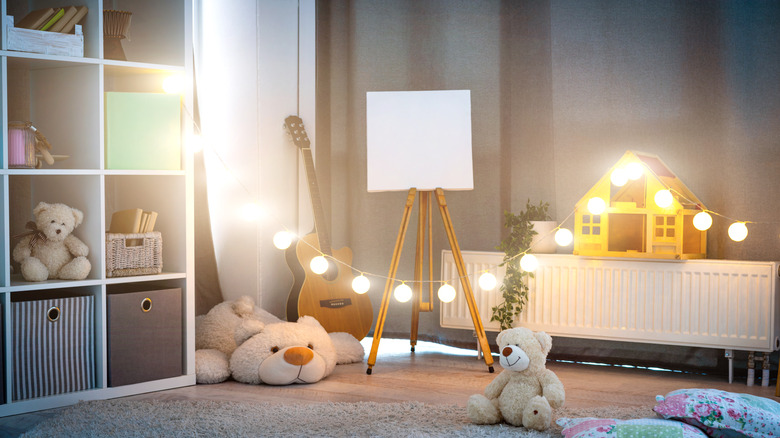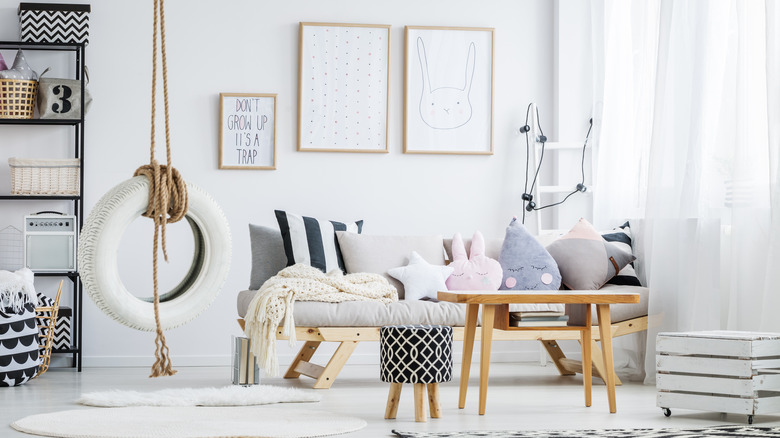The Best Way To Design Your Child's Playroom, According To An Expert
Do you struggle with toys strewn around the living room or hate the middle-of-the-night check on the kids for fear of stepping on a plastic block? Creating a playroom for your child can help with organization. It can also support social, physical, and cognitive growth. Play aids in the development of stronger bonds between family members who play together and supports emotional well-being, according to the American Academy of Pediatrics. The question is, how do you create a playroom that's going to encourage all of these benefits?
In an exclusive interview with House Digest, Karen Aronian, Ed.D., an education design expert and the founder of Aronian Education Design LLC, offers some valuable insights into adding a playroom to your home. "Playrooms can be anywhere you have space for, [or] better yet, places your child gravitates to. Spaces can multitask. Outside, inside, under the stairs, the car hatch all are possibilities." Once you consider location, you'll then need to design a space that hones in on all of the benefits you want to see come out of this investment. Here are Dr. Aronian's recommendations.
Design with specifics and longevity in mind
If you imagine a playroom as just a space for toddlers, you could be missing the long-term benefits that this type of dedicated area can offer. Dr. Aronian shares some key insights into that. "A playroom should be updated and evolve as children grow. Remember to consider the room's walls, ceilings, or floors for their decorative potential and ability to extend a playspace's theme or inform."
Consider your child's needs now, with a plan to make changes in the future. Dr. Aronian shares, "I intentionally design spaces for a child's developmental milestones and frequently update them according to age, interest, and evolving requirements. For instance, I incorporated sensory play and tactile components into a child's home playroom to stimulate a child's vestibular and proprioceptive needs." That may seem hard to do for families with more than one child who may have very different milestone goals to reach. Dr. Aronian offers, "If you are sharing space with multiple kids or in tight quarters, you can section off the room. You can use sheet partitions or painter's tape across the floor to divvy it up."
Customize play space accordingly
Avoid focusing on just one theme or concept in the space. Instead, Dr. Aronian recommends creating a more versatile, flexible space. "What are your children's interests and wishes?" Make sure each area is specific to that child based on their current pursuits. She continues, "Then, create play areas based on their input. These play domains can merge and flex; they need not be static. Toys, sports, music, arts, traditional games, digital gaming, STE(A)M activities, and creative projects all need their compartmentalized zone."
What could you include in them? "With your littles, designate places in the space for the type of play they will do. For example, if they love dress-up, decide where the mirror, hooks for clothes, and props will situate," recommends Dr. Aronian. "If you have a budding artist, dancer, or musician, consider a stage, make the room your canvas, and include a drafting table with an exhibition wall." This may be your child's room, but it can be fun to be creative in designing a space that truly fits their personality and encourages their growth.
Bring in the right kind of storage
Many parents want to provide lots of tools for creative play, and that often means various manipulatives, toys, art supplies, and building kits. It's easy to see how this can make a space become crowded or difficult to keep clean. Dr. Aronian shares some recommendations for this, "Zones should have storage to compartmentalize (categorize) items." Use what you have if you don't want to seek out specially designed or more costly children's organization and storage solutions. "I like to repurpose plastic salad containers to hold playthings and art supplies," she explains.
Take things one step further by creating a designated place for each item. "Use see-thru bins on shelves or stashed under or behind furnishings labeled with the child's name and item for easy grab-and-go play. Kids can make labels for these see-thru boxes," reveals Dr. Aronian. This isn't a task that you have to complete on your own, but instead, one to do together. Allowing them to help may encourage your children to take ownership of their belongings to help keep the space neat and tidy.
Design with temperament in mind
Design can help you to create energy in a space, and with the careful selection of the items and features you add, you can control the outcome. Dr. Aronian explains, "You can transform a high-energy romper room to a serene spot with dim light, soft rug, meditative music, and aromatic scents (like lavender). Consider air filters, essential oil diffusers, and plants to change the ambiance and mood." Each of these items can adjust within the room, too, allowing you to stimulate them or help them wind down at the end of the day.
Another option to incorporate energy is to use color. "Bright colors stimulate children, and muted tones calm things down. Different ages and stages call for optimal (intentional) color considerations," shares Dr. Aronian. "However, the most crucial color decisions should be made by your child; if they have a preference, they're the expert."
You also have windows in this space that contribute to the ambiance and feel of the room through the light they offer, the drapery you add, and even what you set on the windowsill. "Setting up a playroom with windows is ideal for air quality, light, and bringing outside into the inside," she notes. "Make sure the windows have safety guards."
Furnish for maximum fun
Meshing educational materials alongside things that are fun to do doesn't have to be a challenge. It's about choosing those items you know your child will engage with most. Dr. Aronian states, "An easel, jungle gym, and a cozy reading corner outfitted with educational rugs, beanbags, plus pillows and books are ideal. Think about using traditional outside swings, slides, playhouses, and climbers inside." That's sure to create a way to burn off steam, build healthy motor skills, and keep the kids engaged for long periods of time.
Continue to design the space with the addition of elements that add interest. Dr. Aronian has a number of recommendations. "Aim for overhead LED lights; track lights can be installed to highlight areas. Consider exciting add-on features: disco balls, strobes, holiday strings, and personalized lights."
Utilize materials that can grow and change with your child. "Chalkboard paint, whiteboard, mirrored, magnetic walls screened with an overhead projector can create ever-changing backdrops," Dr. Aronian notes. "Finally, if you want to include tech, gaming, and dancing, you can transform or build out your cozy book nook into a media watch spot." With so many ideas, you may want to start making a list of how you'll create a custom playspace for your children.
